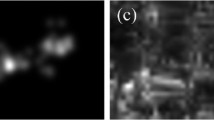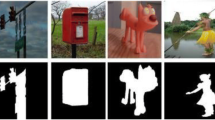Abstract
The paper focuses on the modeling of visual saliency. We present a novel model to simulate the two stages of visual processing that are involved in attention. Firstly, the proto-object features are extracted in the pre-attentive stage. On the one hand, the salient pixels and regions are extracted. On the other hand, the semantic proto-objects, which involve all possible states of the observer’s memories such as face, person, car, and text, are detected. Then, the support vector machines are utilized to simulate the learning process. As a consequence, the association between the proto-object features and the salient information is established. A visual attention model is built via the method of machine learning, and the saliency information of a new image can be obtained by the way of reasoning. To validate the model, the eye fixations prediction problem on the MIT dataset is studied. Experimental results indicate that the proposed model effectively improves the predictive accuracy rates compared with other approaches.




Similar content being viewed by others
References
Wu H, Wang Y, Feng K, Wong T, Lee TY, Heng P. Resizing by symmetry–summarization. ACM Trans Graph. 2010;29(6):1591–9.
Siagian C, Itti L. Biologically-inspired robotics vision Monte-Carlo localization in the outdoor environment. In: IEEE/RSL international conference on intelligent robots and systems; 2007. p. 1723–30.
Tong Y, Cheikh F, Guraya F, Konik H, Tremeau A. A spatiotemporal saliency model for video surveillance. Cogn Comput. 2011;3:241–63.
Harding P, Robertson N. Visual saliency from image features with application to compression. Cogn Comput. 2013;5:76–98.
Treisman AM, Gelade G. A feature-integration theory of attention. Cogn Psychol. 1980;12(1):97–136.
Wolfe JM, Cave KR, Franzel SL. Guided search: an alternative to the feature integration model for visual search. J Exp Psychol Hum Percept Perform. 1989;15(3):419–33.
Koch C, Ullman S. Shifts in selective visual attention: towards the underlying neural circuitry. Human Neurbiol. 1985;4:219–27.
Harel J, Koch C, Perona P. Graph-based visual saliency. In: NIPS; 2006. p. 545–52.
Hou X, Zhang L. Saliency detection: a spectral residual approach. In: CVPR; 2007. p. 1–8.
Achanta R, Hemami S, Estrada F, Süsstrunk S. Frequency-tuned salient region detection. In: CVPR; 2009. p. 1597–604.
Zhai Y, Shah M. Visual attention detection in video sequences using spatiotemporal cues. In: ACM multimedia; 2006. p. 815–24.
Cheng M, Zhang G, Mitra N, Huang X, Hu S. Global contrast based salient region detection. In: IEEE international conference on computer vision and pattern recognition; 2011. p. 409–16.
Li J, Levine MD, An X, Xu X, He H. Visual saliency based on scale-space analysis in the frequency domain. IEEE Trans Pattern Anal Mach Intell. 2013;35(4):996–1010.
Henderson JM, Brockmole JR, Castelhano MS, Mack M. Visual saliency does not account for eye movements during visual search in real-world scenes. In: Eye movements: a window on mind and brain; 2007. p. 537–62.
Navalpakkam V, Itti L. Modeling the influence of task on attention. Vision Res. 2005;45(2):205–31.
Elazary L, Itti L. A bayesian model for efficient visual search and recognition. Vision Res. 2010;50(14):1338–52.
Gao D, Mahadevan V, Vasconcelos N. On the plausibility of the discriminant center-surround hypothesis for visual saliency. J Vis. 2008;8(7):1–18.
Judd T, Ehinger K, Durand F, Torralba A. Learning to predict where humans look. In: IEEE international conference on computer vision; 2009.
Jonides J. Further towards a model of the mind’s eye’s movement. Bull Psychon Soc. 1983;21(4):247–50.
Posner MI, Petersen SE. The attention system of the human brain. Annu Rev Neurosci. 1990;13:25–42.
Posner MI, Rothbart MK. Attention, self-regulation and consciousness. Philos Trans R Soc B Biol Sci. 1998;353:1915–27.
Astle DE, Scerif G. Using developmental cognitive neuroscience to study behavioral and attentional control. Dev Psychobiol. 2009;51(2):107–18.
Rensink R. Seeing, sensing, and scrutinizing. Vision Res. 2000;40(10–12):1469–87.
Felzenszwalb P, McAllester D, Ramanan D. A discriminatively trained, multiscale, deformable part model. In: IEEE conference on computer vision and pattern recognition; 2008. p. 1–8.
Yi C, Tian Y. Text string detection from natural scenes by structure-based partition and grouping. IEEE Trans Image Process. 2011;20(9):2594–605.
Viola P, Jones M. Robust real-time object detection. Int J Comput Vision. 2002;57(2):137–54.
Boser BE, Guyon I, Vapnik V. A training algorithm for optimal margin classifiers. In: COLT; 1992.
Hsieh CJ, Chang KW, Lin CJ, Keerthi SS, Sundararajan S. A dual coordinate descent method for large-scale linear SVM. In: ICML; 2008.
Fawcett T. An introduction to roc analysis. Pattern Recogn Lett. 2006;27(8):861–74.
Hussain A. Cognitive computation: an introduction. Cogn Comput. 2009;1:1–3.
Esposito A. The perceptual and cognitive role of visual and auditory channels in conveying emotional information. Cogn Comput. 2009;1:268–78.
Ma Y-F, Hua X-S, Lu L, Zhang H-J. A generic framework of user attention model and its application in video summarization. IEEE Trans Multimed. 2005;7(5):907–19.
Acknowledgments
This work was supported by the National Natural Science Foundation of China (No. 61302091). Sincere gratitude from the authors goes to Judd and her group for providing the dataset and materials.
Author information
Authors and Affiliations
Corresponding author
Rights and permissions
About this article
Cite this article
Zhao, J., Sun, S., Liu, X. et al. A Novel Biologically Inspired Visual Saliency Model. Cogn Comput 6, 841–848 (2014). https://doi.org/10.1007/s12559-014-9266-z
Received:
Accepted:
Published:
Issue Date:
DOI: https://doi.org/10.1007/s12559-014-9266-z




